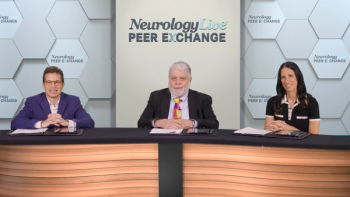
Higher Dose of Nusinersen Shows Greater Impact on Spinal Muscular Atrophy in Phase 2/3 DEVOTE Study
Key Takeaways
- The higher dose of nusinersen improved motor function and slowed neurodegeneration in SMA patients, including treatment-naïve and previously treated individuals.
- Rapid reductions in neurofilament light chain levels were observed with the higher dose, indicating faster neurodegeneration slowing.
Findings from a phase 2/3 study demonstrated the efficacy and safety of a higher dose regimen of nusinersen in treating spinal muscular atrophy in both treatment-naïve and previously treated patients.
New results from Part B and Part C of the phase 2/3 DEVOTE study (NCT04089566) revealed that treatment with an investigational higher dose of nusinersen (Spinraza; Biogen) significantly improved motor function as well as slowed neurodegeneration among both patients previously treated and treatment-naïve with infantile-onset or later-onset spinal muscular atrophy (SMA). Based on these positive findings, the company noted that it plans to file applications for the 50/28-mg higher dose nusinersen regimen with global regulatory agencies.1
Presented at the
“Strikingly, the higher dose regimen lowered neurofilament more quickly, telling us that it’s more rapidly slowing neurodegeneration. We know how critical this is in people living with SMA. Over time, we see evidence of the benefit of the higher dose regimen across SMA phenotypes,”
The DEVOTE study was a comprehensive, 3-part clinical trial involving a total of 145 participants diagnosed with SMA, categorized by age and disease onset. Part B of the study focused on symptomatic infants who had not previously received treatment and Part C included a diverse group of participants, aged between 4 years and 65 years, who had been on the approved 12-mg regimen for at least a median of 3.9 years. Participants in both parts of the study were either administered the investigational higher dose regimen or the standard 12-mg dose, with outcomes measured by various motor function assessments, including Children's Hospital of Philadelphia-Infant Test of Neuromuscular Disorders (CHOP-INTEND) and the Hammersmith Infant Neurological Exam.
READ MORE:
In addition to the primary comparisons between the higher dose regimen and the matched sham group, the company reported new data from secondary analyses that also examined the efficacy of the higher dose regimen compared with the approved 12-mg nusinersen regimen. Although the study was not sufficiently powered to detect statistically significant differences between these groups, secondary findings consistently favored the higher dose regimen in most comparisons.
In these data, presented at the 2024 WMS Annual Congress, treated patients had a 94% reduction in plasma neurofilament light chain (NfL) from baseline to day 183, compared with a 30% reduction in the sham control group (P <.0001). Moreover, the higher dose regimen demonstrated more rapid reductions in NfL, with greater reductions observed at day 64 compared with the 12-mg regimen (nominal P =.0050).
At day 302, participants treated with the higher dose showed a 19.6-point improvement on the CHOP-INTEND, and those who received the 12 mg regimen had a 21.6-point improvement (least-squares mean difference, -1.94; P = .8484). Similarly, the higher dose group showed a slight but not statistically significant improvement in the Hammersmith Infant Neurological Exam section 2 (HINE-2) compared with the 12 mg-group (least-squares mean difference, 0.58; P =.1734).
The higher dose regimen also significantly reduced the risk of death or permanent ventilation by 67.8% relative to the sham group (HR, 0.322; P = .0006), and by 29.9% compared with the 12-mg regimen (HR, 0.701; P = .2775). This reduction in severe outcomes was accompanied by a similar trend in overall survival and a decrease in hospitalizations and serious respiratory events.
In a separate cohort of later-onset participants in Part B, those who received the higher dose regimen showed numerically greater improvements in motor function, as measured by the HFMSE and the RULM, compared with the 12-mg group at day 302. These improvements were also observed in comparison to prespecified matched 12-mg and sham control groups from the phase 3 CHERISH study (NCT02292537).
The higher dose regimen of nusinersen was generally well-tolerated across all parts of the DEVOTE study. The safety profile was consistent with the approved 12-mg regimen, with the most common adverse events (AEs) being respiratory infections, fever, constipation, and headaches. Notably, the frequency of AEs was similar across both the 50/28-mg and 12-mg treatment arms. AEs what led to study withdrawal or death occurred only in the Part B treatment-naïve cohort and were 20% (n = 10), 24% (n = 6) and 55% (n = 11), in the 50/28-mg, 12-mg and matched sham arms, respectively.
“While we’ve seen great progress over the past decade in improving the lives of those with SMA, gaps remain and we can do more to address the full range of unmet needs and goals within our community,” Kenneth Hobby, president of
REFERENCES
1. New Higher Dose Nusinersen Efficacy and Safety Data Presented at World Muscle Society Congress, Highlight Potential to Maximize Benefit of Nusinersen in SMA. News Release. Biogen. Published October 8, 2024. Accessed November 26, 2024. https://investors.biogen.com/news-releases/news-release-details/new-higher-dose-nusinersen-efficacy-and-safety-data-presented
2. Biogen Announces Positive Topline Results from Study of Higher Dose Regimen of Nusinersen, Showing Significant Benefit in Treatment of SMA. News Release. Biogen. Published September 4, 2024. Accessed November 26, 2024. https://investors.biogen.com/news-releases/news-release-details/biogen-announces-positive-topline-results-study-higher-dose
Newsletter
Keep your finger on the pulse of neurology—subscribe to NeurologyLive for expert interviews, new data, and breakthrough treatment updates.




































